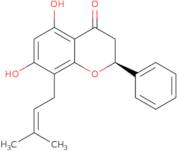
Produktinformation
- Glabranine(2S)-2,3-Dihydro-5,7-dihydroxy-8-(3-methyl-2-buten-1-yl)-2-phenyl-4H-1-benzopyran-4-one
- (2S)-2,3-Dihydro-5,7-dihydroxy-8-(3-methyl-2-buten-1-yl)-2-phenyl-4H-1-benzopyran-4-one
- (2S)-5,7-Dihydroxy-8-(3-methylbut-2-enyl)-2-phenyl-2,3-dihydrochromen-4-one
- 4H-1-Benzopyran-4-one, 2,3-dihydro-5,7-dihydroxy-8-(3-methyl-2-butenyl)-2-phenyl-, (2S)-
- 4H-1-Benzopyran-4-one, 2,3-dihydro-5,7-dihydroxy-8-(3-methyl-2-butenyl)-2-phenyl-, (S)-
- 4H-1-benzopyran-4-one, 2,3-dihydro-5,7-dihydroxy-8-(3-methyl-2-buten-1-yl)-2-phenyl-, (2S)-
- Glabranin
- Glabranin (flavonoid)
- Glabranine
Pinocembrin is a naturally occurring phenolic compound that is found in the plant Acacia pennata, or Australian pine. Pinocembrin has been shown to inhibit melanogenesis and thus may be useful for treating skin disorders such as melasma and vitiligo. It also has antimicrobial activity against oral pathogens but not against human pathogens. 8-Prenylpinocembrin has been shown to have a long-term toxicity of 2 years and can cause metabolic disorders in animals. This chemical pesticide also inhibits protein synthesis in vitro and has been shown to be effective against a number of bacterial strains and fungi.
Chemische Eigenschaften
Technische Anfrage zu: 3D-XP161632 8-Prenylpinocembrin
Wenn Sie ein Angebot anfordern oder eine Bestellung aufgeben möchten, legen Sie stattdessen die gewünschten Produkte in Ihren Warenkorb und fordern Sie dann ein Angebot oder eine Bestellung an aus dem Warenkorb. Es ist schneller, billiger und Sie können von den verfügbaren Rabatten und anderen Vorteilen profitieren.





